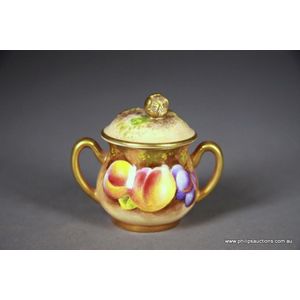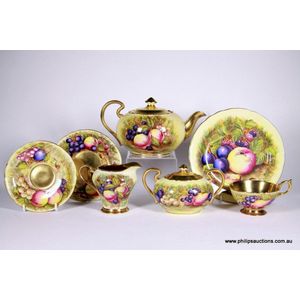Aynsley Orchard Gold Tea Set
You must be a subscriber, and be logged in to view price and dealer details.
Subscribe Now to view actual auction price for this item
When you subscribe, you have the option of setting the currency in which to display prices to $Au, $US, $NZ or Stg.
- Gilding - Gilding is a method of ornamentation whereby a thin sheet of gold metal is applied to items made of wood, leather, ceramics, glass and silver for decorative purposes.
For furniture including mirrors, the sheet of gold is usually applied over a coating of gesso. Gesso is a mixture of plaster of Paris and gypsum mixed with water and then applied to the carved wooden frames of mirrors and picture frames as a base for applying the gold leaf. After numerous coats of gesso have been applied, allowed to dry and then sanded a coat of "bole", a usually red coloured mixture of clay and glue is brushed on and allowed to dry, after which the gold leaf is applied. Over time parts of the gilding will rub off so the base colour can be seen. In water gilding, this was generally a blue colour, while in oil gilding, the under layer was often yellow. In Victorian times, gilders frequently used red as a pigment beneath the gold leaf.
Metal was often gilded by a process known as fire gilding. Gold mixed with mercury was applied and heated, causing the mercury to evaporate, the long-term effect of which was to kill or disable the craftsman or woman from mercury poisoning. The pursuit of beauty has claimed many victims, not the least of which were the artists who made those pieces so highly sought after today.
This item has been included into following indexes:
Visually similar items

A signed miniature Royal Worcester covered cup, 1955, the slightly squat cup with a flower encrusted domed lid and gilded handles decorated with richly toned peaches and purple plums upon a mottled amber brown base; backstamp underside and indistinctly sig

A Royal Worcester amphora vase, two handled, adorned with dainty bulbous white daisy bouquets on blush ivory ground and heightened in gilt. Date code 1892. Height 18.5 cm

A Dresden lidded urn, hand-decorated with applied floral decoration, height 16 cm

Royal Worcester lidded urn. Dual handled. Hand painted fruit dec. Signed Hollings, circa 1900s. Small chip inside lid. Height 17 cm
